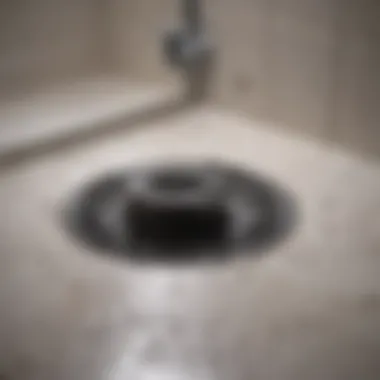Effective Techniques for Clearing Hair from Shower Drains


Intro
Cleaning hair from shower drains is an ongoing challenge for homeowners and design enthusiasts alike. The accumulation of hair not only disrupts the aesthetic of a bathroom but can also lead to significant plumbing issues if left untreated. Understanding the causes of clogs and exploring effective methods to address them is an essential part of home maintenance. This article delves into practical solutions that ensure drainage systems remain functional and pleasant.
Common Causes of Clogs
Hair clogs in shower drains happen for several reasons. Firstly, long strands of hair tend to tangle and form a web-like structure, making it difficult for water to flow freely. Secondly, over time, soap residue, skin cells, and other debris can build up, providing a sticky surface for hair to latch onto.
Regular cleaning and preventive measures can greatly reduce the regularity of these clogs, maintaining a smooth drain flow.
Preventive Measures
Preventive measures can save time and effort in the long run. Consider these tips:
- Install Drain Screens: These can catch hair and prevent it from entering the drain.
- Routine Cleaning: Remove visible hair and debris weekly if possible.
- Use a Vinegar and Baking Soda Solution: This natural mixture can break down buildup when used once a month.
By implementing these preventive measures, homeowners can address potential issues before they escalate.
Cleaning Methods for Hair Removal
When it comes to cleaning hair from shower drains, there are several methods you can adopt:
Manual Removal
Using your hands or a hook-like tool can be an effective way to dislodge hair from the drain. If possible, this method provides immediate results and requires minimal effort.
Plumber’s Snake
A plumber's snake is a long, flexible tool that can reach deep clogs. Using it involves inserting the snake into the drain until you feel resistance, then twisting and pulling to retrieve hair and debris.
Wet/Dry Vacuum
A wet/dry vacuum can also tackle hair clogs efficiently. By creating a seal around the drain and using the vacuum's suction, you can pull hair and other debris out of the drain.
Chemical Drain Cleaners
There are various products designed specifically to dissolve hair in plumbing systems. Be cautious when using these, as they can be harsh on older pipes. Always follow the instructions carefully.
Professional Help
If the clog persists even after trying DIY methods, seeking professional plumbing services may be necessary. Professionals have access to advanced tools and expertise to handle significant blockages.
Tools Required for Effective Cleaning
To tackle hair clogs, you will need a few tools. Here are some essentials:
- Drain Snake: Versatile for different types of clogs.
- Drain Screen: Helpful for prevention.
- Wet/Dry Vacuum: Ideal for heavy clogs.
- Gloves and Bucket: Always protect your hands and be prepared for potential spills.
Tips for Maintaining Clear Drainage
Maintaining clear drainage requires consistent effort. Here are some recommendations:
- Avoid Using Too Much Hair Products: Products can contribute to residue buildup.
- Rinse Your Shower Regularly: After each use, give a quick rinse to minimize buildup.
- Consider the Type of Hair Products You Use: Some hair treatments can lead to quicker clogs due to added ingredients that stick to the hair.
The End
Understanding Shower Drain Issues
Understanding the issues that arise with shower drains is critical for maintaining a functional bathroom. Clogs often result in slow drainage, unpleasant odors, and, in severe cases, flooding. This section aims to detail the complexities of drain issues, emphasizing their impact on both daily living and overall home condition.


Identifying and addressing the causes of clogs can lead to effective solutions that save time and money in the long run. Not only does a clear drain enhance hygiene, but it also mitigates further plumbing complications. Regular awareness of shower drain conditions allows homeowners to adopt proactive cleaning practices, thus ensuring a seamless bathing experience.
Common Causes of Drain Clogs
Drain clogs can stem from various sources. A predominant factor is hair accumulation, which easily binds with soap scum and other debris.
- Hair: Strands can easily cluster around the drain, creating a problematic blockage.
- Soap Residue: Soap, especially solid bar types, can leave behind a sticky buildup when combined with hair.
- Grease and Oil: While shower drains are less likely to encounter cooking oils, shower gel or body oil can contribute to clogs over time.
- Foreign Objects: Small items like jewelry or hygiene products often slip into the drain, contributing to blockages.
The Role of Hair in Bathroom Drainage Problems
Hair is a common culprit in shower clogs. It has the unique ability to weave into existing debris, creating a dense mass that accumulates over time.
This mass typically traps soap scum and shampoo residue, effectively forming a stubborn blockage that resists simple cleaning methods. Understanding how hair interacts with other materials in the drain highlights the difficulty of resolving these issues once they arise. Proactive measures to minimize hair collection can significantly decrease the likelihood of clogs.
Signs of a Clogged Shower Drain
Detecting a clog early can prevent costly damage and complicated repairs. Look for these indicators of a clogged shower drain:
- Slow Drainage: Water does not drain quickly as usual when hair or debris begins to build up.
- Unpleasant Odors: A stagnant water smell can indicate a serious blockage, often due to decaying organic matter.
- Gurgling Sounds: Unusual sounds from the drain often signal air trapped behind a blockage.
- Frequent Overflowing: Water backing up can indicate severe drainage issues that require immediate attention.
Regular inspection of shower drains can save you from extensive plumbing work down the road. Keeping an eye out for these signs is the first step towards effective prevention.
Preparation for Cleaning
Preparation is a crucial step in the process of cleaning hair from shower drains. For effective results, having the right tools and understanding safety precautions makes a noticeable difference. Proper preparation not only saves time but also minimizes the risk of injury or damage to your plumbing.
Gathering Necessary Tools
Basic Tools
A selection of basic tools is essential for tackling hair clogs in shower drains. Common tools include a screwdriver, gloves, and a small bucket.
The screwdriver helps to remove the drain cover and allows easier access to the clogged area. Gloves protect hands from both dirty water and sharp objects that may be present in the drain. A bucket is useful for catching any debris or water that spills out during cleaning.
The main characteristic of these basic tools is their accessibility and ease of use. They are readily available in most homes or can be purchased at local hardware stores. Their simplicity makes them a beneficial choice for homeowners who prefer to engage in DIY cleaning solutions.
The unique feature of these tools is that they allow for a hands-on approach. However, they might not be sufficient for more severe clogs that require specialized equipment.
Chemical Cleaners
Chemical cleaners play a significant role in drain maintenance. These products often contain strong acids or enzymes that can effectively break down hair and other organic materials that clog drains.
Their key characteristic is the rapid action; they often provide quick results, which can be appealing for busy individuals who need immediate solutions.
The advantage of using chemical cleaners is their convenience. They are easy to apply and often come with instructions for effective use. However, there can be disadvantages too. Chemical cleaners may pose safety risks, including potential harm to the plumbing system or user if not handled properly. Additionally, repeated use of these substances can harm the environment and lead to costly plumbing repairs in the long run.
Natural Alternatives
Natural cleaning alternatives offer a non-toxic approach to clearing hair from drainages. Ingredients such as baking soda, vinegar, and salt can be effective for unclogging showers.
Their key characteristic is the eco-friendliness; they do not contain harsh chemicals and avoid the risks associated with traditional cleaners. This makes them a popular choice for environmentally-conscious individuals.
One unique feature of these natural alternatives is their dual-action capabilities. For instance, the combination of baking soda and vinegar creates a fizzing reaction that can help dislodge hair clogs. While effective in many cases, the downside is that these methods may not be sufficient for tough clogs or extreme situations. In such cases, they may require more effort and multiple applications.
Safety Precautions to Consider
Safety precautions are vital when preparing to clean shower drains. Always wear gloves to avoid direct skin contact with bacteria and chemicals. If using chemical cleaners, read the labels carefully. Ensure the area is well-ventilated. Some chemicals release fumes that can irritate the respiratory tract. Additionally, avoid mixing different chemical cleaners, as this can create harmful reactions.
Manual Cleaning Techniques
Manual cleaning techniques are critical when dealing with hair clogs in shower drains. These methods allow homeowners to take control of the situation without relying on harsh chemicals or expensive appliances. By manually addressing the problem, one can often restore drainage effectively and understand better the underlying causes of clogs.
The primary advantage of these techniques is their simplicity. Many of the tools required for manual cleaning are readily available in most households. This accessibility makes it easier for anyone to maintain clear drains, prolonging the need for professional assistance.


Using this approach, you can often achieve immediate results. It promotes a hands-on attitude that builds knowledge about drain management. Understanding various manual techniques can also prevent future clogs, saving both time and money.
Using a Plumber's Snake
A plumber's snake, also known as a drain auger, is an essential tool in effectively removing hair clogs. This flexible tool can navigate through tight bends in piping, reaching deep into the drain structure. By twisting and pushing the snake, you can break up hair clogs and remove them from the pipe. Using this method is often straightforward, as it requires minimal training.
The adaptability of a plumber's snake allows it to tackle various types of blockages. Additionally, it is environmentally friendly compared to chemical drain cleaners. The only consideration is that the user should be prepared to deal with some mess, as pulling a snake out of a clogged drain may result in extracting a handful of unpleasant debris.
Employing a Wet/Dry Vacuum
A wet/dry vacuum can be seen as a versatile ally in the fight against shower drain clogs. It operates by creating suction to pull hair and other debris from the drain. This technique can be particularly effective if the clog is near the top of the drain.
One key benefit of using a wet/dry vacuum is its ability to handle both liquid and solid waste. This makes it not only useful for clearing hair but also for cleaning up spills and other messes. However, it is necessary for users to ensure that the vacuum's hose is properly sealed to create sufficient suction, or the results might be disappointing.
Hand Removal of Visible Hair
Hand removal can be an effective, if somewhat less pleasant, method for dealing with visible hair in the shower drain.
Accessing the Drain
Accessing the drain is a critical step in this process. It involves removing the shower drain cover to expose the clump of hair that has formed. To do this, most covers can be unscrewed or pryed up. This direct access allows for a thorough cleaning.
The key characteristic of accessing the drain is that it enables you to see the problem firsthand. This visibility can offer insights into how often clogs occur and from where the hair accumulates. While it is a straightforward option, one must consider hygiene factors when removing debris by hand.
Best Practices for Hand Removal
When removing hair by hand, certain practices can enhance the effectiveness of the process. Wearing rubber gloves can protect your hands from germs and make handling hair easier. Pulling the clump out gently reduces the risk of tearing it and leaving behind remnants that could cause future clogs.
Another unique feature of this method is the ability to assess drain condition directly. It allows the user to determine if additional cleaning or maintenance is necessary. While hand removal is effective, it may not be suitable for everyone due to the unpleasantness of dealing with trapped hair directly. Nonetheless, it remains an essential component of a well-rounded approach to drain management.
Chemical Drain Cleaners
Chemical drain cleaners provide homeowners with a practical solution for clogged shower drains without the need for extensive manual labor. When hair accumulates and creates blockages, some people reach for these products to quickly dissolve the debris. These cleaners contain powerful chemicals designed to break down organic matter, including hair, soap residue, and other remnants that hinder drainage. While their effectiveness is often praised, it is essential to understand how they work and what considerations one should bear in mind before using them.
Understanding Drain Cleaner Chemicals
Chemical drain cleaners can be broadly categorized into several types based on their composition. Common ingredients include sodium hydroxide, sulfuric acid, and hydrochloric acid. Each of these substances plays a role in dislodging clogs. For instance, sodium hydroxide generates heat when mixed with water, which can help to melt away grease and hair. On the other hand, sulfuric acid effectively breaks down organic material but can be very hazardous if not handled properly.
It is crucial to follow the instructions provided by the manufacturer. Misuse of these chemicals can lead to harmful reactions, including the production of toxic fumes. Some drain cleaners also contain enzymes or bacteria designed to consume organic material, thus presenting a more eco-friendly alternative. However, they may take longer to work compared to harsher chemical options. Always read the label to understand the specific uses and limitations of each product.
How to Use Chemical Cleaners Safely
Safety is paramount when working with chemical drain cleaners. Here are some key steps you should take:
- Wear protective gear: This includes gloves, goggles, and a mask to protect your skin, eyes, and lungs from potential splashes and fumes.
- Ventilate the area: Ensure that the bathroom is well-ventilated. Open windows or use a fan to disperse any harmful vapors that might arise.
- Follow instructions diligently: Stick to the manufacturer's instructions regarding application and wait time.
- Avoid mixing products: Do not combine different types of chemical cleaners. Mixing can result in dangerous reactions, potentially generating toxic gases.
- Flush with water: After the recommended wait time, flush the drain thoroughly with hot water. This helps to wash away any residue and ensures other materials do not interact with the chemicals.
"The improper use of drain cleaners can lead to more significant plumbing issues and potential harm to the user. Always prioritize safety."
Chemical drain cleaners can be effective in maintaining your shower drains. However, they should be employed with caution. Understanding how they work and following proper safety protocols will help you effectively deal with hair clogs while minimizing potential risks.
Natural Cleaning Alternatives
Natural cleaning alternatives provide a safe and environmentally friendly way to maintain clean shower drains. These methods leverage common household items that not only break down hair clogs but also minimize chemical exposure. For homeowners, the appeal lies in the dual advantage of being both economically viable and effective. The absence of harsh chemicals also supports home health, especially in households with children or pets.
Baking Soda and Vinegar Method
The baking soda and vinegar method stands out as a classic and powerful solution to unclog drains. Its chemical reaction generates fizzing and bubbling, which helps to dislodge hair and debris. To utilize this method, pour half a cup of baking soda directly down the drain, followed by a half cup of vinegar. This combination should sit for about 30 minutes before flushing it with hot water. Not only does this method clean the drain, but it also helps to neutralize odors, making it a practical choice for regular maintenance.
Boiling Water Technique


Using boiling water is often an overlooked yet effective cleaning technique. This method is straightforward and requires no additional ingredients. Simply bring a kettle or pot of water to a boil and then carefully pour it down the drain. The heat from the boiling water can help melt and wash away fatty deposits and hair clumps that may be causing a blockage. This technique should be used cautiously; it is not suitable for all types of plumbing, particularly plastic pipes, as extreme heat may cause damage.
Salt and Baking Soda Mixture
Another natural alternative involves combining salt and baking soda. This mixture helps to scrub away buildup in the pipes. The recommended ratio is one cup of salt mixed with one cup of baking soda. Pour the mixture down the drain and follow it with boiling water. This method takes advantage of the abrasive nature of salt, paired with the fizzing of baking soda, creating an effective mechanism against hair and other debris clogs. Regular use can help mitigate the accumulation of hair, leading to fewer drainage issues overall.
"Natural alternatives often prove to be just as effective as chemical solutions while prioritizing safety and health at home."
Incorporating these natural cleaning alternatives into regular maintenance routines may significantly improve the performance of shower drains. These methods are not only cost-effective but safe, ensuring a cleaner and healthier home environment.
Preventive Measures
Preventive measures are essential in maintaining clean and functional shower drains. Clogged drains often lead to costly repairs and can harm the overall aesthetics of a bathroom. Taking specific steps can greatly reduce the accumulation of hair and debris, ultimately preserving not only the functionality of the draining system but also enhancing the long-term durability of plumbing fixtures.
By implementing these measures, homeowners can save time and effort in cleaning while minimizing the need for chemical interventions. Consistency in these practices fosters a more pleasant bathing experience and ensures that water flows freely during showers.
Importance of Drain Covers
The use of drain covers plays a significant role in preventing hair and other debris from entering the drainage system. By acting as a barrier, these covers effectively trap hair before it slips down the drain. This simple addition can significantly reduce the frequency of clogs and the amount of cleaning required.
Regularly checking and cleaning drain covers is also important. Dust and soap scum can accumulate, leading to blockage if neglected. Durable materials like stainless steel or silicon offer long-lasting solutions, ensuring that the cover remains effective over time.
"A small investment in a quality drain cover can save thousands on plumbing repairs in the long run."
Regular Maintenance Routines
Establishing a regular maintenance routine is crucial in keeping shower drains clear. Performing simple tasks can make a major difference. Homeowners should aim to clean the strainer or drain cover weekly to remove hair and debris. This small act can significantly decrease the likelihood of clogs.
Flushing the drain with hot water every month helps dissolve soap residues and grease that may accumulate over time. Additionally, using a mixture of baking soda and vinegar periodically can help clear out minor blockages without the use of harsh chemicals. Regular maintenance routines create a proactive approach rather than a reactive one. By taking these steps, one can avoid invasive plumbing repairs and ensure a well-functioning shower.
When to Call a Professional
Determining when to call a professional for shower drain issues can be crucial. Homeowners often assume they can manage minor clogs on their own. However, there are several factors that suggest enlisting expert help may be more effective. This decision should be weighed carefully.
Assessing Severe Clogs
Severe clogs can manifest in various ways. If you notice water draining unusually slowly or not at all, it might indicate a more significant blockage. DIY methods may alleviate mild issues, but persistent drainage problems warrant professional inspection.
Common signs of severe clogs include:
- Multiple drains backing up – If the shower drainage is impacted, but other fixtures like the sink or toilet are also affected, the problem may reach further into the plumbing system.
- Persistent odors – Unpleasant smells should not be ignored. A foul odor often indicates trapped organic material or sewage, which may pose health risks.
- Gurgling sounds – These noises during draining can reflect trapped air trying to escape. It can signal serious blockages further down the pipe.
- Frequent backflow – If water routinely backs up into your shower, professional assistance may be necessary to clear the underlying source of the limit.
For each of these signs, a licensed plumber can precisely diagnose and address the issue using specialized equipment. Avoid risking further damage or personal injury by attempting to fix complex problems alone.
Understanding Plumbing Issues
Plumbing issues often extend beyond simple clogs. A malfunctioning or damaged pipe can lead to serious complications. Homeowners need to recognize the limitations of DIY approaches. Here are some common plumbing problems requiring professional expertise:
- Tree root intrusion – Roots can disrupt pipe systems, leading to significant blockages. Only a plumber can determine the extent of the damage.
- Pipe corrosion or breakage – Over time, pipes can corrode or fracture, leading to leaks or structural damage in your property.
- Improper installation – Previous poor installations can create ongoing headaches. Identifying installation faults typically necessitates professional assessment.
- Age of plumbing system – Older homes, especially those with outdated plumbing systems, may face unique challenges that require professional experience.
Finale
Cleaning hair from shower drains is an essential task for maintaining both the functionality and hygiene of your bathroom. Ignoring clogs can lead to severe drainage problems, which may be costly to fix. Therefore, understanding the methods available for cleaning hair from drains can save time, money, and unnecessary stress.
Summary of Effective Cleaning Strategies
In summary, the effective methods discussed throughout this article can be grouped into several key strategies:
- Manual Cleaning: Utilizing tools like a plumber's snake or a wet/dry vacuum can aid in removing hair clogs directly. Hand removal of visible hair is also a straightforward method, as long as safety precautions are observed.
- Chemical Cleaners: Understanding the composition and proper use of chemical drain cleaners is crucial. They can provide a more potent solution for stubborn clogs but require caution to avoid damage to plumbing or personal injury.
- Natural Alternatives: Employing household items such as baking soda, vinegar, or boiling water offers a chemical-free option which is gentler on both the plumbing and the environment.
- Preventive Measures: Installing drain covers and establishing regular maintenance routines can significantly decrease the likelihood of hair buildup.
- Professional Help: Recognizing when to seek the expertise of a plumber can prevent further complications. Especially for severe clogs or underlying plumbing issues, professional intervention is often necessary.
"Prevention is better than cure; a well-maintained drain saves significant time and resources in the long run."
Encouragement for Ongoing Drain Maintenance
Maintaining your shower drains should become a regular part of your home care routine. Integrating simple habits can greatly enhance the lifespan of your plumbing. Here are a few recommendations:
- Regular Cleaning Schedule: Establish a routine to check and clean your drains every month. This can be as simple as running hot water with vinegar and baking soda to help dissolve minor build-up.
- Use of Drain Covers: Place drain covers in your shower to catch hair and debris before it slips down the drain. Regularly remove and clean these covers to avoid any buildup.
- Awareness of Clog Signs: Keep an eye out for slow drainage or unusual noises. Early detection can prevent more severe plumbing issues.







